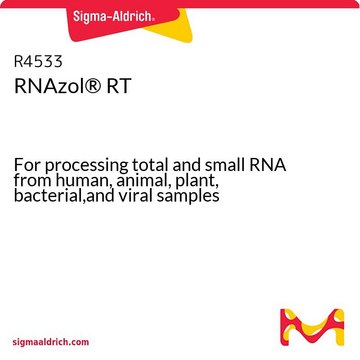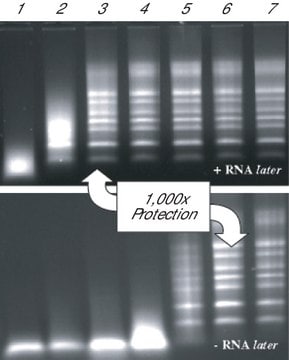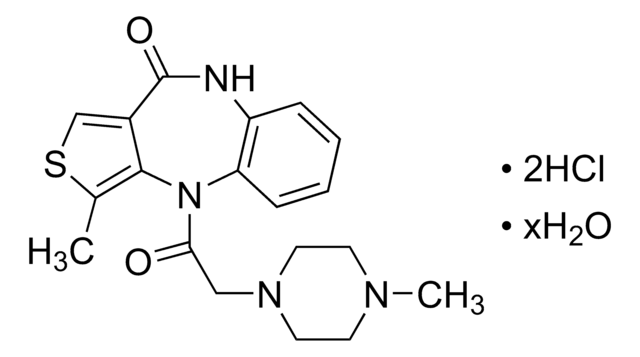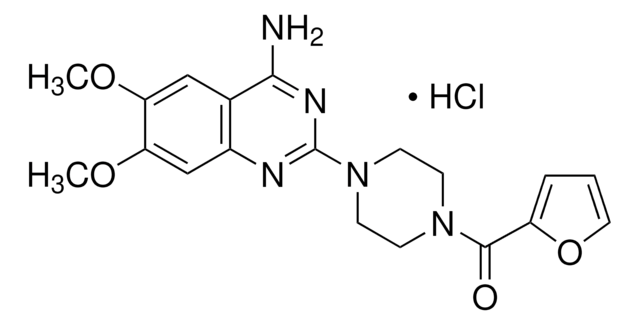T9424
TRI Reagent®
For processing tissues, cells cultured in monolayer or cell pellets
Synonym(s):
DNA/RNA/protein extraction reagent, DNA/RNA/protein isolation reagent, DNA/RNA/protein purification reagent, TRI Reagent® cell pellet solution, cell pellet RNA extraction, cell pellet RNA isolation, cell pellet RNA purification, single step RNA extraction reagent, single step RNA isolation reagent, single step RNA purification reagent, total RNA extraction solution, total RNA isolation solution, total RNA purification solution, TRI Reagent® RNA Isolation Reagent
About This Item
Recommended Products
Quality Level
usage
mL sufficient for 107 cells
mL sufficient for 100 mg tissue (or)
storage temp.
2-8°C
Looking for similar products? Visit Product Comparison Guide
Related Categories
General description
Homogenization or lysis of the tissue sample in TRI reagent® dissolves RNA, DNA and protein. The addition of chloroform or 1-bromo-3-chloropropane followed by centrifugation results in the separation of the mixture into three phases: an aqueous phase containing the RNA, the interphase containing DNA, and an organic phase containing proteins. Each of the components can then be isolated after separating the phases.
Application
- in the isolation of total RNA from various tissue samples and cells
- for the lysis of monocytes
- to isolate cytoplasmic RNA from SARS-CoV infected Vero cells
- to isolate total RNA from MDMs (monocyte-derived macrophages) infected with influenza A (H5N1) virus
- to prepare a viral lysate of SARS-CoV culture for the creation of a clone encoding the S glycoprotein in the development of SARS-CoV vaccine
The RNA, DNA and protein that are isolated using TRI reagent® can further be used for downstream applications, such as cloning, PCR, RT-PCR, Northern blots, mRNA isolation, in vitro translation, RNase protection assay, restriction enzyme digestion, Southern blots, SDS-PAGE and western blots.
Features and Benefits
Multi-purpose: TRI Reagent® performs well with large or small amounts of tissue or cells and works with many samples including human, plant, yeast, bacterial and viral samples.
Efficient: TRI reagent® gives better yields than traditional guanidine thiocyanate/cesium chloride methods. The whole process of RNA extraction starting with fresh tissue or cells can be completed in less than one hour.
- Easily scalable RNA isolation
- Works with many sources: human, plant, yeast, bacterial, or viral
- Better yields than traditional guanidine thiocyanate/cesium chloride methods
Legal Information
related product
Signal Word
Danger
Hazard Statements
Precautionary Statements
Hazard Classifications
Acute Tox. 3 Dermal - Acute Tox. 3 Inhalation - Acute Tox. 3 Oral - Aquatic Chronic 2 - Eye Dam. 1 - Muta. 2 - Skin Corr. 1B - STOT RE 2
Target Organs
Nervous system,Kidney,Liver,Skin
Supplementary Hazards
Storage Class Code
6.1A - Combustible acute toxic Cat. 1 and 2 / very toxic hazardous materials
WGK
WGK 2
Flash Point(F)
174.2 °F - closed cup
Flash Point(C)
79 °C - closed cup
Certificates of Analysis (COA)
Search for Certificates of Analysis (COA) by entering the products Lot/Batch Number. Lot and Batch Numbers can be found on a product’s label following the words ‘Lot’ or ‘Batch’.
Already Own This Product?
Find documentation for the products that you have recently purchased in the Document Library.
Customers Also Viewed
Articles
The availability of simple methods for purification of DNA and RNA has greatly facilitated the analysis and characterization of the genome and gene expression. There is a demand to isolate DNA and RNA rapidly and conveniently from a variety of cellular sources, including cells and tissues from mammalian, plant and bacterial cultures.
Protocols
Cultrex™ 3-D Culture Cell Harvesting Kit provides an optimized and standardized solution for the isolation and normalization of cell lysates from 3-D Culture Matrix™ BME or Laminin I for subsequent biochemical analysis.
Protocol for Anti Ago-RNA Immunoprecipitation from mammalian cells using the RIP kit
Related Content
An overview of cell lysis and protein extraction methods including detergent solubilization, freeze-thaw lysis, osmotic shock, sonication, enzymatic cell lysis, and mechanical disruption techniques such as Dounce, Polytron, and mortar and pestle homogenization.
Our team of scientists has experience in all areas of research including Life Science, Material Science, Chemical Synthesis, Chromatography, Analytical and many others.
Contact Technical Service















